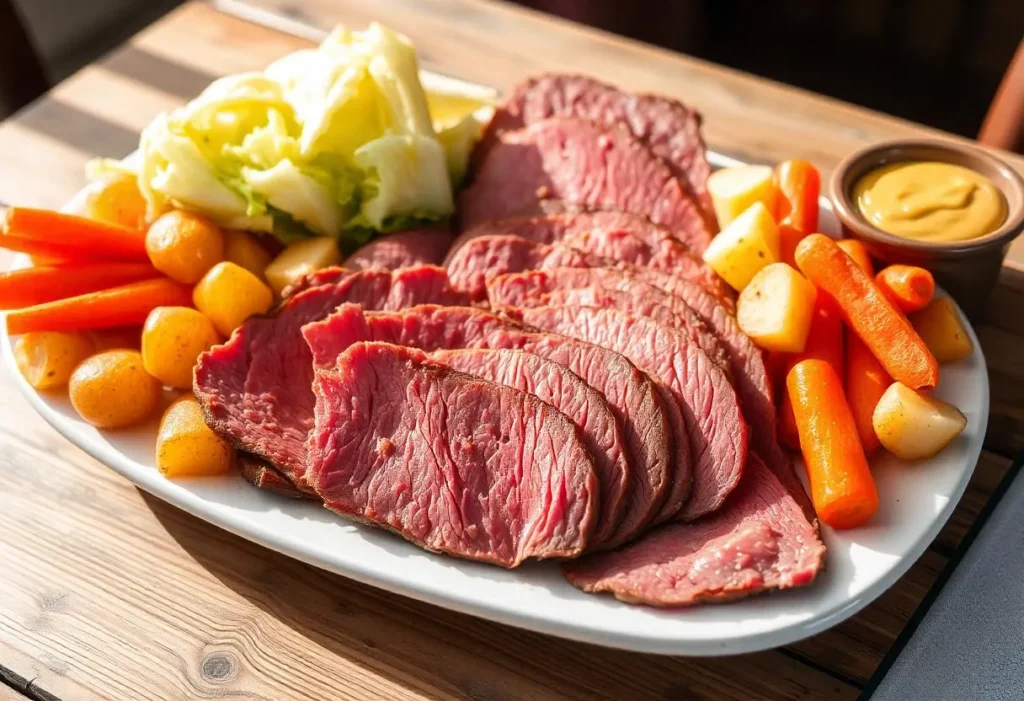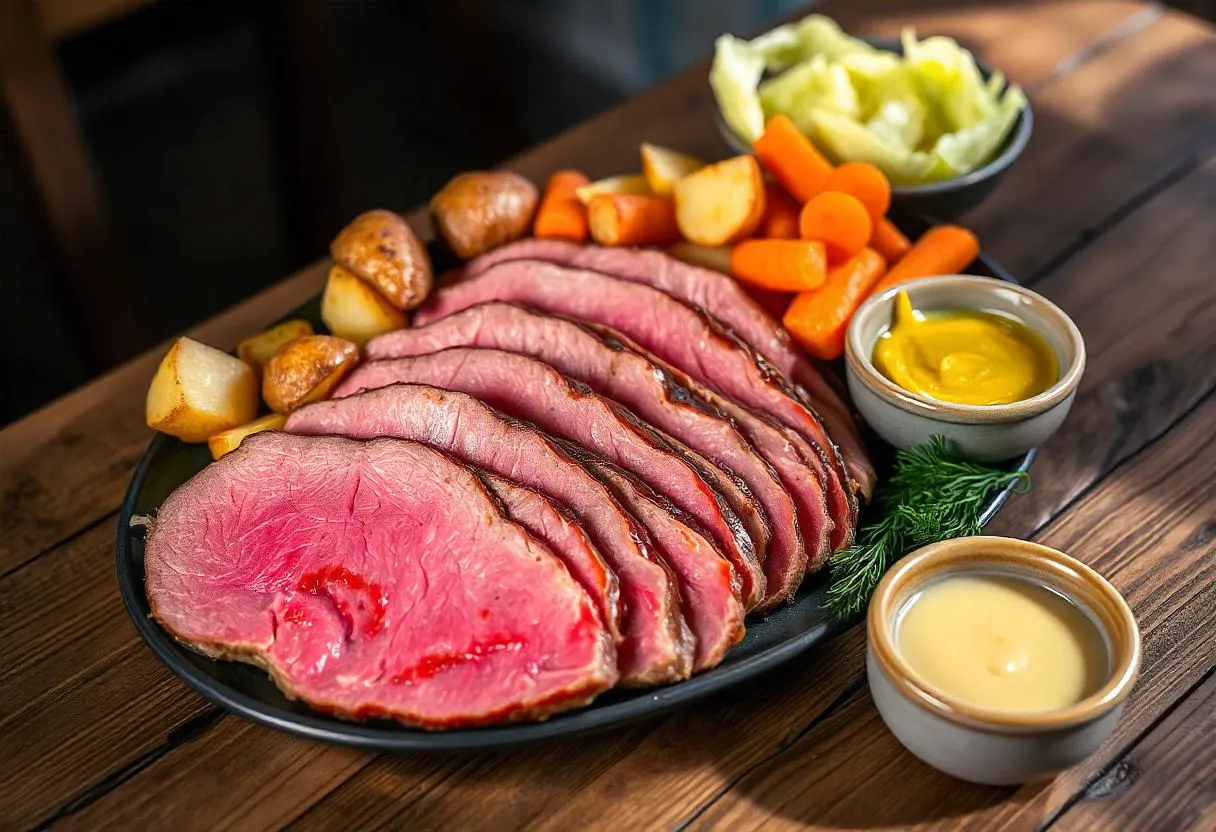Introduction
Corned beef is one of those comfort foods that always sparks curiosity. What makes it so flavorful? How does it get its signature briny taste? This guide will unravel the fascinating process behind making corned beef, from selecting the perfect cut of meat to achieving the tender, mouthwatering results that make this dish a household favorite. Whether you’re planning a festive meal or just diving into culinary exploration, you’re in for a treat. Let’s dig in! 🥩
Table of Contents
What Is Corned Beef?
Corned beef isn’t just any beef it’s a specially cured product with a unique flavor profile. The term “corned” refers to the large grains of rock salt (historically called “corns”) used in the curing process. These salt crystals, combined with spices, preserve the meat and impart its distinct savory and slightly tangy flavor.
Corned beef is most commonly associated with St. Patrick’s Day, but its appeal spans cultures and cuisines. From hearty sandwiches to warming stews, corned beef has carved out a special place in many kitchens.
A Brief History of Corned Beef
Did you know that corned beef has been around for centuries? Originating in Ireland during the 17th century, it was initially a way to preserve meat before refrigeration existed. Ireland’s abundance of cattle and salt made it a global supplier of corned beef, though much of it was exported rather than consumed locally.
During the 19th century, corned beef gained popularity in the United States, particularly among Irish immigrants. However, what we think of as “traditional” Irish and cabbage is actually an Irish-American invention!
Ingredients Required to Make Corned Beef
Essential Ingredients
To make authentic corned beef, you’ll need the following:
- Beef brisket: The preferred cut, known for its balance of fat and muscle.
- Kosher salt: The key ingredient for curing the meat.
- Pink curing salt (optional but recommended): Gives its signature reddish color and enhances preservation.
- Sugar: Balances the saltiness of the brine.
- Spices: A mix of peppercorns, coriander, cloves, mustard seeds, and bay leaves.
Optional Add-Ins for Flavor
For a personalized touch, consider adding:
- Garlic cloves
- Fresh thyme
- Juniper berries
- Ginger slices
These additions can elevate your brine and infuse the beef with complex flavors.
The Corned Beef Preparation Process
Selecting the Right Cut of Beef
The foundation of great corned beef lies in the brisket. It’s a tough cut that benefits from long cooking times, resulting in the tender texture is famous for. Look for a brisket with a good fat cap for flavor.
Pro Tip: Flat-cut brisket is ideal for even cooking, while point-cut brisket is more marbled and flavorful.
Creating the Brine Solution
The brine is the magic potion that transforms brisket into. Combine water, kosher salt, pink curing salt, sugar, and spices in a large pot. Heat the mixture to dissolve the ingredients, then let it cool completely before submerging the beef.
Block Quote:
“A proper brine is the heart of corned beef it’s what gives the meat its signature taste. Don’t rush this step!”
Brining the Beef
Once the brine is ready, place the beef brisket in a large, non-reactive container (glass or stainless steel). Pour the brine over the meat until fully submerged. Cover and refrigerate for 5-10 days, flipping the brisket every few days to ensure even curing.
Emoji Tip: 🕒 Patience is key here the longer you brine, the deeper the flavor penetrates the meat.

Cooking Corned Beef to Perfection
After brining, rinse the brisket thoroughly to remove excess salt. Then, place it in a pot and cover it with water or beef stock. Add more spices, like bay leaves and peppercorns, for enhanced flavor.
Simmer the beef gently for 3-4 hours until fork-tender. If you’re short on time, try a slow cooker or pressure cooker for equally delicious results.
Nutrition Facts and Benefits
Nutritional Breakdown
Here’s a snapshot of the nutritional profile (per 3-ounce serving):
| Nutrient | Amount |
|---|---|
| Calories | 210 |
| Protein | 15g |
| Fat | 16g |
| Sodium | 900mg |
| Iron | 15% DV |
While corned beef is high in sodium, it’s also a good source of protein and iron.
Is Corned Beef Healthy?
Corned beef can be part of a balanced diet when consumed in moderation. Pair it with vegetables like cabbage or carrots for a more nutritious meal.
Emoji Tip: 🥦 Adding greens helps balance the richness of corned beef while boosting fiber and vitamins.
Stovetop Method
The traditional way to cook is on the stovetop. Start by placing the brined beef in a large pot, covering it with water or beef stock. Add aromatics like bay leaves, onion, and garlic. Bring the liquid to a boil, then reduce the heat to a gentle simmer. Allow the beef to cook for 3-4 hours, or until it is tender enough to be easily pierced with a fork.
Pro Tip: Skim any foam that rises to the surface during cooking to keep the broth clear.
Slow Cooker Approach
If you prefer a hands-off method, the slow cooker is your best friend. Place the beef in the slow cooker, cover it with water or stock, and add spices and vegetables. Set the cooker on low for 8-10 hours or high for 4-5 hours.
Block Quote:
“Using a slow cooker allows the meat to cook evenly and ensures it absorbs all those rich, aromatic flavors.”
Instant Pot Shortcut
Pressed for time? The Instant Pot can deliver tender, flavorful in a fraction of the time. Place the beef and your brine or stock in the pot, lock the lid, and set it to high pressure for about 90 minutes. Allow for a natural pressure release to maintain tenderness.
Emoji Note: ⏱️ Save hours of cooking time without compromising taste!
Common Problems and Solutions While Making
Beef Not Tender Enough
that feels tough or chewy usually hasn’t been cooked long enough. Brisket requires low and slow cooking to break down the connective tissues. Extend the cooking time, and keep the temperature low to avoid overcooking.
Block Quote:
“Remember: tough corned beef is a sign it needs more time, not less.”
Overly Salty Flavor
If your ends up tasting too salty, rinsing the brisket thoroughly after brining is essential. For extra caution, soak the brisket in cold water for an hour before cooking.
Emoji Hack: 💧 Soaking the beef helps draw out excess salt, creating a more balanced flavor.
Tips for Better Texture and Flavor
- Slice against the grain: This ensures tender slices that are easier to chew.
- Add vegetables late: Include carrots, potatoes, and cabbage in the last hour of cooking to prevent them from becoming mushy.
- Experiment with spices: Customize the brine with allspice, cinnamon, or even chili flakes for a unique twist.
Serving Suggestions for
Pairing Corned Beef with Side Dishes
pairs wonderfully with traditional sides like cabbage, potatoes, and carrots. For a hearty meal:
- Mashed potatoes: Creamy potatoes balance the richness of the beef.
- Buttered cabbage: A classic partner that absorbs the meat’s flavor.
- Irish soda bread: Ideal for soaking up juices.
Block Quote:
“Corned beef becomes a feast when paired with simple, rustic sides that complement its bold flavors.”
Using Corned Beef in Other Recipes
Leftover corned beef is a treasure trove of culinary possibilities! Try these ideas:
- Reuben sandwich: Layer, sauerkraut, Swiss cheese, and Russian dressing on rye bread.
- Corned beef hash: Combine chopped beef with potatoes and onions, then fry until crispy.
- Tacos: Add shredded to soft tortillas, topped with slaw and a tangy dressing.
Frequently Asked Questions About
How Long Should Corned Beef Be Brined?
For optimal flavor, brine for at least 5 days, but up to 10 days for a deeper cure. Flip the brisket every few days to ensure even penetration of the brine.
Can You Freeze?
Yes! Cooked can be frozen for up to 3 months. Wrap it tightly in aluminum foil or freezer-safe bags to prevent freezer burn. Thaw it in the refrigerator overnight before reheating.
Emoji Tip: 🧊 Freezing is a great way to extend the shelf life of this delicious meat.
Why Is It Called “Corned” Beef?
The name comes from the large salt crystals (called “corns” of salt) used in the curing process. These “corns” help preserve the beef while giving it its signature taste.
Conclusion
Making corned beef is a rewarding process that brings rich flavors to your table. With a little patience and the right techniques, you can craft a dish that’s perfect for any occasion. From its fascinating history to its versatile uses, is truly a culinary gem. Why not give it a try? Your taste buds will thank you!

